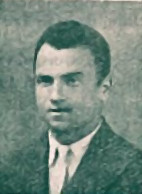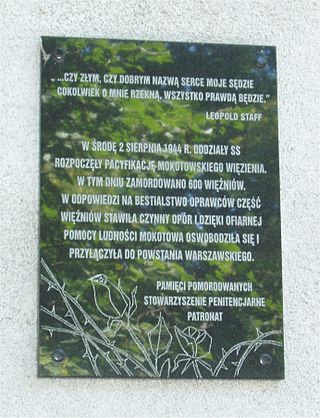Related Research Articles

Around six million Polish citizens are estimated to have perished during World War II. Most were civilians killed by the actions of Nazi Germany, the Soviet Union, the Lithuanian Security Police, as well as the Organization of Ukrainian Nationalists and its offshoots.

The 3rd Light Division was raised in November 1938. In 1939 it fought in the Invasion of Poland. On 4 September 1939, soldiers from the division entered the region of Katowice where they met resistance from the local Polish population. In retribution 80 Polish prisoners of war were gathered in Kosciuszko Square by German soldiers and executed.
The 2nd Light Division was a motorized division created in 1938 during the German rearmament. It participated in the invasion of Poland. After the end of the Polish campaign the division was converted into a panzer division, forming the 7th Panzer Division.

The 4th Panzer Division was an armored division in the Army of Nazi Germany.

Fritz Witt was a Waffen-SS commander during the Nazi era. During World War II, he served with the SS Division Leibstandarte before taking command of the SS Division Hitlerjugend. He was killed in action in June 1944.

Szymon Datner was a Polish historian, Holocaust survivor and underground operative from Białystok, best known for his studies of the Nazi war crimes and events of The Holocaust in the Białystok region. His 1946 Walka i zagłada białostockiego ghetta was one of the first studies of the Białystok Ghetto.

During World War II, the German Wehrmacht committed systematic war crimes, including massacres, mass rape, looting, the exploitation of forced labor, the murder of three million Soviet prisoners of war, and participated in the extermination of Jews. While the Nazi Party's own SS forces was the organization most responsible for the genocidal killing of the Holocaust, the regular armed forces of the Wehrmacht committed many war crimes of their own, particularly on the Eastern Front.

Wieruszów County is a unit of territorial administration and local government (powiat) in Łódź Voivodeship, central Poland. It came into being on January 1, 1999, as a result of the Polish local government reforms passed in 1998. Its administrative seat and only town is Wieruszów, which lies 106 kilometres (66 mi) south-west of the regional capital Łódź.

The Ciepielów massacre that took place on 8 September 1939 was one of the largest and best documented war crimes of the Wehrmacht during its invasion of Poland. On that day, the forest near Ciepielów was the site of a mass murder of Polish prisoners of war from the Polish Upper Silesian 74th Infantry Regiment. The massacre was carried out by soldiers from the German Army's 15th Motorized Infantry Regiment, 29th Motorized Infantry Division, under the command of Colonel Walter Wessel.
The 18th Infantry Division is a division of the Polish Armed Forces. The division was originally part of Polish Army during the interbellum period, which took part in the Polish September Campaign. Stationed in Łomża and commanded in 1939 by Colonel Stefan Kossecki, it was part of the Narew Independent Operational Group.

Serock is a village in the administrative district of Gmina Pruszcz, within Świecie County, Kuyavian-Pomeranian Voivodeship, in north-central Poland. It lies approximately 9 kilometres (6 mi) west of Pruszcz, 25 km (16 mi) west of Świecie, and 28 km (17 mi) north of Bydgoszcz.
The Massacre in Zakroczym, Poland, took place on 28 September 1939 when, in spite of a cease-fire, soldiers of Panzerdivision Kempf stormed Polish positions at Zakroczym, where soldiers from the 2nd Infantry Division were getting ready to surrender. Hundreds of Polish soldiers were murdered. The rest were beaten and abused. Many civilians were killed or wounded. German troops broke into houses, robbed them, set on fire, and tossed hand grenades into the basements filled with scared civilians. Kazimierz Szczerbatko estimated, based on the testimony of the eyewitnesses, that the Germans killed around 500 soldiers and 100 civilians.

The Suppression of Mokotów was a wave of mass murders, looting, arson and rapes that swept through the Warsaw district of Mokotów during the Warsaw Uprising in 1944. Crimes against prisoners of war and civilians of the district were committed by the Germans until the capitulation of Mokotów on September 27, 1944, although they intensified in the first days of the uprising.

The Massacre in the Mokotów prison was a mass murder of residents of the Mokotów Prison in Warsaw by the Germans on the second day of the Warsaw Uprising. On August 2, 1944, soldiers of the Waffen-SS - SS-Pz. Gren. Ausb.-und Ers. Btl. 3 shot about 600 Poles on the premises of the prison at 37 Rakowiecka Street. It was one of the biggest crimes committed by the Germans in Mokotów during the suppression of the Warsaw Uprising. During the massacre, some prisoners actively resisted the Nazis, which allowed several hundred people to escape to the area controlled by the insurgents.

The Zambrów massacre was a war crime that took place on the night of 13–14 September 1939. It was one of the major war crimes of the Wehrmacht during the invasion of Poland. During that night, the makeshift prisoner-of-war camp in Zambrów was disturbed by a number of panicked horses, and more than 200 Polish soldiers, trying to move out of their way, were gunned down by German sentries. Some witnesses later said the horses had been purposely released into the camp by the German sentries, who used the incident as a pretext to massacre the prisoners.

During the German invasion of Poland, which started World War II, Nazi Germany carried out a number of atrocities involving Polish prisoners of war (POWs). During that period, the Wehrmacht is estimated to have mass murdered at least 3,000 Polish POWs, with the largest atrocities being the Ciepielów massacre of 8 September 1939 and the Zambrów massacre of 13–14 September. Most of those atrocities are classified as war crimes of the Wehrmacht. Jewish soldiers with the Polish Army were also more likely than others to be victims of various atrocities.
The Majdan Wielki massacre, which occurred on September 20, 1939, near the village of Majdan Wielki, was a war crime committed by the Wehrmacht during its invasion of Poland. On that day, 42 Polish prisoners of war were executed by German soldiers due to false reports alleging that Poles had mutilated a dead German soldier.

The Szczucin massacre, which occurred on September 12, 1939, in the village of Szczucin, was a war crime committed by the Wehrmacht during its invasion of Poland. On that day, at least 40 Polish prisoners of war and around 30 civilian refugees were either shot or burned alive in the local school building. Later, 25 Jews who were brought there to bury the bodies of the earlier massacre victims were also executed by Wehrmacht soldiers.

The Torzeniec massacre, which occurred on September 1–2, 1939, in the village of Torzeniec was a war crime committed by the Wehrmacht during its invasion of Poland. During these days, soldiers of the 10th Infantry Division killed 37 Poles, including 34 inhabitants of Torzeniec, while the village itself was partially burned.

The Wyszanów massacre, which occurred on September 2, 1939, in the village of Wyszanów was a war crime committed by the Wehrmacht during its invasion of Poland. On that day, 22 Poles, mostly elderly people, women, and children, died from bullets, flames, and grenades thrown into the basements. Men from Wyszanów who were able to carry weapons had been deported to Germany the day before, and en route, two of them were killed by guards.
References
- 1 2 3 4 5 Datner, Szymon (1961). Zbrodnie Wehrmachtu na jeńcach wojennych armii regularnych w II wojnie światowej [Wehrmacht crimes against prisoners of war in World War II] (in Polish). Wydawnictwo MON. pp. 56–57.
- ↑ Studia Historyczne [Historical Studies] (in Polish). Państwowe Wydawn. Naukowe, Oddz. w Krakowie. 1984. p. 143.
- 1 2 "Śledztwa – S 17/05/Zn" [Investigations – S 17/05/Zn]. ipn.gov.pl (in Polish). Archived from the original on 2008-05-17. Retrieved 2023-11-04.
- ↑ Böhler, Jochen (2009). Zbrodnie Wehrmachtu w Polsce[Wehrmacht crimes in Poland] (in Polish). Wydawnictwo "Znak". p. 184.